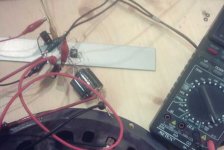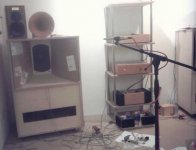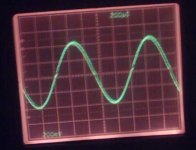I have tried many thing to get the OPA544 to work as a Gainclone, and have given up.
I went back to the datasheet and found that the THD graph was quoted into a load of 15Ohm, and it looks prity bad at that. Into an average speaker this thing will and does distort to hell- and its nasty, peaky distortion at that.
I finally got it working to a just about acceptable level by having a 10ohnm resistor in series with the output- there is still noticable distortion.
I just hope I haven't damaged my tweeter !!!
Shoog
I went back to the datasheet and found that the THD graph was quoted into a load of 15Ohm, and it looks prity bad at that. Into an average speaker this thing will and does distort to hell- and its nasty, peaky distortion at that.
I finally got it working to a just about acceptable level by having a 10ohnm resistor in series with the output- there is still noticable distortion.
I just hope I haven't damaged my tweeter !!!
Shoog
Well, it should not distort "as hell" with 8 ohms if it is put together correctly. Care to post a diagram of your circuit?
Jan Didden
Jan Didden
OPA544 power output 30W (min) @ 1kHz: 0,03 % THD+N
specified by TI:
http://focus.ti.com/docs/apps/catalog/resources/appnoteabstract.jhtml?abstractName=sboa082
But i would use OPA548 or 549.
specified by TI:
http://focus.ti.com/docs/apps/catalog/resources/appnoteabstract.jhtml?abstractName=sboa082
But i would use OPA548 or 549.
I am using it with the circuit values specified on the datasheet, and with a 20k 10k and 2.2k voltage divider on the input.
I am using it on a printed circuit board. It is perfectly quiet at rest and is doesn't have any high frequency ocillation to speak of.
This opamp doesn't respond well to a low impedence load.
Shoog
I am using it on a printed circuit board. It is perfectly quiet at rest and is doesn't have any high frequency ocillation to speak of.
This opamp doesn't respond well to a low impedence load.
Shoog
I can find no evidence of anyone else using this chip as a gainclone(after extensive searching on the web). If anyone has had a better experience with this chip and can sujested component values to stop this distorting I would be very interested. Otherwise its back to the LM1875.
I have tried it with bypass cap on the supply lines, with a cap to earth on the input, with a 10ohm resistor and parallel inductor on the output. I don't think there are many more things I can try to get this working.
I would stand by my comment that it is "distorting to hell" in the midrange.
Shoog
I have tried it with bypass cap on the supply lines, with a cap to earth on the input, with a 10ohm resistor and parallel inductor on the output. I don't think there are many more things I can try to get this working.
I would stand by my comment that it is "distorting to hell" in the midrange.
Shoog
TI says the OPA544 could be used as audio power amplifier as you could see in the app note i linked above.
If this is true you shoud send them an email and they will test it and correct the app note.
I would try to use another OPA544, because it may be you damaged yours.
You do not use a 80dB/1W 1,6Ohm speaker?
For a speaker that needs more than these 2A you definitely must use a high current version like OPA549.
This opamp doesn't respond well to a low impedence load.
If this is true you shoud send them an email and they will test it and correct the app note.
I would try to use another OPA544, because it may be you damaged yours.
You do not use a 80dB/1W 1,6Ohm speaker?
For a speaker that needs more than these 2A you definitely must use a high current version like OPA549.
I have had this distortion consistently from one set of chips to another.
My speakers are in excess of 90db and are run fullrange with a helper tweeter crossed over with a cap and padding resistor.
I have experienced the same distortion on fullrange drivers without helper tweeters.
Please describe your experience with this chip.
Shoog
My speakers are in excess of 90db and are run fullrange with a helper tweeter crossed over with a cap and padding resistor.
I have experienced the same distortion on fullrange drivers without helper tweeters.
Please describe your experience with this chip.
Shoog
Please describe your experience with this chip.
Please give me a moment time.
How much power did you run from the chip in which impedance ? 8Ohm?
And what voltage from power supply?
I am running it with 18volt supply lines (with a very beefy transformer), and the speakers are about 7ohm load.
Shoog
Shoog
i have to say i´m not experienced what is a lot distortion.
What i did: I build a inverting OPA544 amp, feeding it from PC with 1kHz sine wave. Pluged it to my horn speakers (remember what Nelson says about DIYers, fearless and so) , put an ECM8000 in front of the speaker, feed signal into soundcard, asked spectralab:
at 2.8V AC/measured with true RMS meter, output 0,85 THD, at 10V 0,7%, at 16V 6,5% !
with Zen V4 it gives: 2,8V 0,2 and at 10V 1 %.
What i did: I build a inverting OPA544 amp, feeding it from PC with 1kHz sine wave. Pluged it to my horn speakers (remember what Nelson says about DIYers, fearless and so) , put an ECM8000 in front of the speaker, feed signal into soundcard, asked spectralab:
at 2.8V AC/measured with true RMS meter, output 0,85 THD, at 10V 0,7%, at 16V 6,5% !
with Zen V4 it gives: 2,8V 0,2 and at 10V 1 %.
6.5% at 16V would seem to confirm my assertion, or am I misreading you.
I used a scope to monitor my tests and saw notches on the up and downs of the waves. It also seemed to be feeding back some sort of distortion to the signal generator, which manifested as ocillation of the output. I put this down to a fault in the signal generator, but I am not so certain anymore.
Shoog
I used a scope to monitor my tests and saw notches on the up and downs of the waves. It also seemed to be feeding back some sort of distortion to the signal generator, which manifested as ocillation of the output. I put this down to a fault in the signal generator, but I am not so certain anymore.
Shoog
Yes, the 16V value confirms you.
But, as i sayed i´m not experienced with this, i expected much higher values, because in this measurement chain are a lot sources for distortion: soundcard, the OPA544, the speaker, the mik, the preamp, again the soundcard. Also i don´t know the funktion THD from the speaker goes up with voltage.
For me the most interesting is the THD is lower with the Zen at reasonable level - at 2,8V the system is really loud.
I´m to tires now to measure without the speaker/ mik, amp output direct into soundcard.
But, as i sayed i´m not experienced with this, i expected much higher values, because in this measurement chain are a lot sources for distortion: soundcard, the OPA544, the speaker, the mik, the preamp, again the soundcard. Also i don´t know the funktion THD from the speaker goes up with voltage.
For me the most interesting is the THD is lower with the Zen at reasonable level - at 2,8V the system is really loud.
I´m to tires now to measure without the speaker/ mik, amp output direct into soundcard.
I have a Zen V3 driving the same speakers at the moment and they sound sweet and clear, I know its not the speakers at fault (unless the OPA544 doesn't like the cap crossover).
I have my Gainclone setup in none inverting mode. I would imagine from your figures that the distortion might well be climbing with voltage so the figure might be even higher at 18volts.
I can assure you that I have done nothing stupid ion my setup, and the evidence of my own ears says that this chip distorts in a very nasty way with speaker loads.
The only audio circuit I have seen it used in was bridged driving piezo speakers.
Shoog
I have my Gainclone setup in none inverting mode. I would imagine from your figures that the distortion might well be climbing with voltage so the figure might be even higher at 18volts.
I can assure you that I have done nothing stupid ion my setup, and the evidence of my own ears says that this chip distorts in a very nasty way with speaker loads.
The only audio circuit I have seen it used in was bridged driving piezo speakers.
Shoog
yes, it climbs badly with voltage. It is a lot more at 18V But also this the power range the amp must distort. It says clearly: max 2A.
So it could not be used behond this area of about 16V . I doubt on a high efficient speaker you ever need more than the 10V.
May it be (non class a)/ chipamps are crap because there is more distortion at low power?
So it could not be used behond this area of about 16V . I doubt on a high efficient speaker you ever need more than the 10V.
May it be (non class a)/ chipamps are crap because there is more distortion at low power?
I have just aquired a very nice regulated 13Volt supply which I will try to see if there is any improvement. I could then concievably drop the voltage again by using a lower voltage supply and see if it becomes acceptable.
Still it doesn't seem to measure up well when compared to the LM1875
Shoog
Still it doesn't seem to measure up well when compared to the LM1875
Shoog
Iam not certain I agree that the max current is listed as 2A. It say that as the voltage increases to the supply line the current is pulled back to 2A from a max of 4A. If the amp is supplied at 18V- half its maximum, then it shouldn't be under much strain, especially at low wattage output - say 5watts - which is what I am driving it at about.
Shoog
Shoog
- Home
- Amplifiers
- Chip Amps
- opa544 will not work as a Gainclone.


